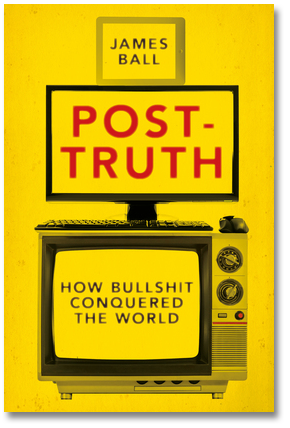Post-Truth, book review: The facts about 'alternative facts'


Post-Truth: How Bullshit Conquered the World • by James Ball • Biteback Publishing • 306 pages • ISBN: 978-1-785-90214-7 • £9.99
The opposite of truth isn't lies; it's bullshit. Liars are still invested in the difference between truth and fiction, whether their lying is a means to an end, a habit, or a pathology. Bullshitters don't care what's true, and can therefore be far more damaging, as Buzzfeed reporter James Ball writes in Post-Truth: How Bullshit Conquered the World.
Ball prefers 'bullshit' to 'fake news' as a specific reference to Princeton University professor Harry Frankfurt's well-known paper On Bullshit (PDF), which sought to examine the theoretical underpinnings of the category and trace the history of the genre. The short version of Ball's offering: there's a lot of it about, and while we all think we can recognise it, many factors come together to interfere -- but there's still hope.
Ball begins by discussing the impact of disinformation on the two examples currently foremost in everyone's mind: the election of Donald Trump to the US presidency, and the Brexit vote. From there, he segues into the sources who are to blame. Few escape, as he names politicians, old and new media, fake media, social media, and 'you'. In the third section of the book, Ball talks about why bullshit works: psychology, cognitive biases, profit structures and incentives, and surrounding culture. Finally, he closes with some thoughts about how to stem the flow.
Before landing at Buzzfeed, Ball was a volunteer for Wikileaks, where he worked on the Iraq War Logs documentaries and was involved in the Cablegate publication of 250,000 classified diplomatic cables, and a special projects editor at The Guardian, where he reported on the Snowden leaks. He knows more than most, therefore, about examining sources and studying the difference between private and public utterances.
BS in the internet age
Much of the book's material is at least somewhat familiar to anyone who has been reading the news for the last year. Bullshit has always emerged from multiple sources and types of sources. What's new is the scope the internet gives to new entrants like Macedonian village teens exploiting the attention economy for pocket money, and Russian hacker gangs set on spreading divisiveness to undermine the democracy of foreign nations. The psychology of why we believe -- and share -- bullshit is also not terribly new, but is helpfully explained and placed in context.
More urgent is how to effect change. Ball's cognitive material underlines the fact that explaining and fact-checking further embeds false claims rather than eliminating them. We still have to do it, but it's more effective to intervene at an earlier stage -- for example, by writing headlines that indicate up front when a story is bogus; by not using trendy stories (like "fake news") to divert attention from the really hard problems we need to solve; by teaching media literacy; and by building public media. For readers and voters, he offers a suggestion akin to the late journalist Molly Ivins' advice to read widely among things you disagree with: to "burst your bubble".
My one complaint would be that Ball only examines part of a much larger puzzle. We can -- and should -- do all the things he suggests. But we are up against adversaries who will try to interfere at every stage. As a problem, bullshit -- or fake news -- is, as I've written elsewhere, on the scale of cybersecurity. Fixing our relationship with the media is just one piece.
Read more book and film reviews
- A Mind at Play, book review: The life and work of information theory's founding father
You can use the internet without understanding any of Claude Shannon's work. But there is value in knowing how the technologies we use every day got here. This excellent biography is a good place to start. - Crash Override, book review: Gamergate and the battle against online hate
Game developer Zoë Quinn recounts her experience of 'Gamergate', which prompted the creation of the Crash Override Network to provide support and advice for victims of online hate. - The Political Spectrum, book review: How wireless deregulation gave us the iPhone
Thomas Winslow Hazlett offers an accessible history of wireless technology, describing how regulators often stifled innovative competition under pressure from incumbent interests, and how deregulation eventually gave us FM radio, HBO, wi-fi, and the iPhone. - Risk, film review: Access all Assange areas, to incoherent effect
Over six years of filming, Laura Poitras follows the elusive and distant Wikileaks founder from a friend's Norfolk estate to his Ecuadorian Embassy bolt-hole.